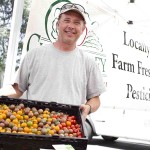 According to the U.S. Department of Agriculture’s (USDA) comprehensive National Directory of Farmers Markets, the number of farmers markets increased by 16 percent between 2009 and 2010. Arizona lists 74 markets in this directory, with two in Flagstaff. “People are more conscientious about what they are eating. A lot of them are coming out to the farmers market buying fresh vegetables and fruit,” said Fred Wong of Wong’s Farm. “I think, overall, everybody sees that it’s better to buy locally grown products.” The two Flagstaff farmers markets, named Flagstaff Community Markets, are managed by Art and Heather Babbott. “Flagstaff has a great culture which values and appreciates local foods, but before the markets, there wasn’t a lot of ability for local people to access that food,” said Art Babbott. “The markets help re-connect the community with people who grow their food and make sure more of our dollars stay in the community.”
According to the U.S. Department of Agriculture’s (USDA) comprehensive National Directory of Farmers Markets, the number of farmers markets increased by 16 percent between 2009 and 2010. Arizona lists 74 markets in this directory, with two in Flagstaff. “People are more conscientious about what they are eating. A lot of them are coming out to the farmers market buying fresh vegetables and fruit,” said Fred Wong of Wong’s Farm. “I think, overall, everybody sees that it’s better to buy locally grown products.” The two Flagstaff farmers markets, named Flagstaff Community Markets, are managed by Art and Heather Babbott. “Flagstaff has a great culture which values and appreciates local foods, but before the markets, there wasn’t a lot of ability for local people to access that food,” said Art Babbott. “The markets help re-connect the community with people who grow their food and make sure more of our dollars stay in the community.”
The downtown farmers market is now in its tenth season. “The market has grown incredibly. Our first year was four weeks with six vendors,” said Babbott. “Now we have 32 weeks with 70 to 80 vendors. On a Sunday market, we will typically have 1,500 people come through in a short period of time.”
The Wednesday market in Sunnyside, started in 2009, has around 30 vendors with approximately 500 customers. “This is a neighborhood market,” said Babbott. “We felt strongly about putting this market here to provide access for people who typically can’t get to super fresh, organically grown produce.” Both markets are certified by the USDA to accept food stamps and WIC vouchers (Special Supplemental Nutrition Program for Women, Infants and Children).
“I think the most important thing that we have been a part of is providing farm-to-market sales that make the economical viability of small growers significantly better than it was ten to fifteen years ago,” said Babbott. “…A ten acre farm is a big farm for us; we have the whole spectrum, from 10 to 20 acres down to a quarter acre.” Farmers are charged $35 per season plus ten percent of what they make during the market to participate in the farmers market. According to Babbott, participants collect anywhere from $100 to $3,500 during the Sunday market.
“A farmer can’t tell you if they have made any money until the end of the season, because it’s not like they make widgets and every week they know what their costs are,” said Mike O’Connor-Masse of Chino Valley Farms. “Plants can die. We pick our tomato plants for four months, the same plants. So, what is its productivity? I don’t know until I tear it down.” O’Connor-Masse started selling at farmers markets 14 years ago when Prescott formed its first market. Linda Downey and her husband, Paul, started Downey Farms in Chino Valley three years ago because they were concerned about where their food was coming from. Now the farm is Linda’s full-time job.
“I go to five farmers markets,” said Downey.
“From April through October, I work 40 to 80 hours per week and get about five hours of sleep per night.” Babbott said, “If you are incredibly hard working and have a good abil- ity to do marketing of these events [farmers markets] you can make a decent wage and have a lifestyle that is very attractive for some people. That’s all because of direct farm-to- market sales.”
On a Sunday in August, melons, mush- rooms, basil, tomatoes, apples, summer squash and watermelons were available, among other produce. Mario Valeruz, gardener for Garland’s Lodge, sells excess produce and organic apples from the Lodge’s garden and orchards. The Flagstaff market also encourages backyard gardeners to sell their excess produce at the market. Some vendors have locally-made fresh goods, called value-added or processed foods, including honey, cheese, breads, etc. that are available year round.
“It’s important to remember that 10, 15 years ago there was a very informal local foods movement in Flagstaff,” said Babbott. “And in those ensuing years, between the CSA (Community Supported Agriculture), the community markets, and some of the restaurant distribution, we’re probably well over a million dollars in total sales that is kept regionally that used to just go away.” FbN





